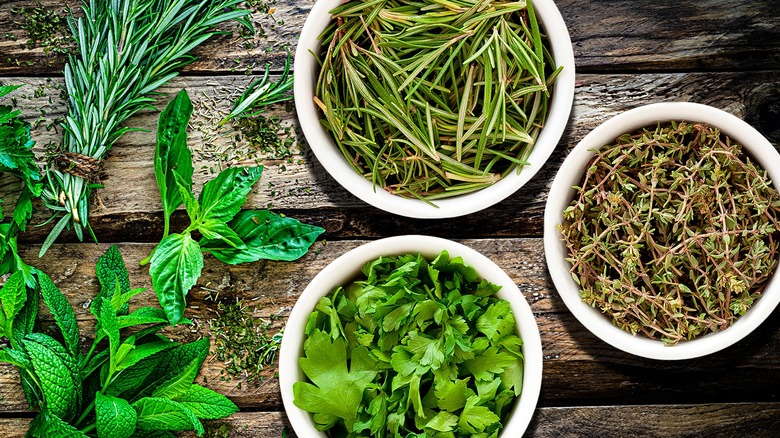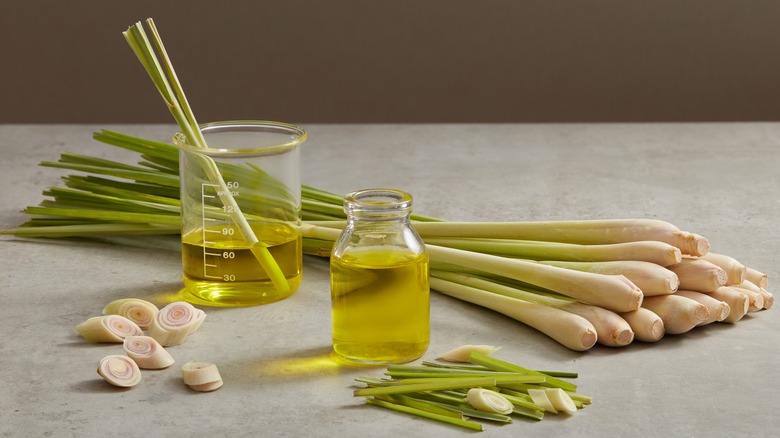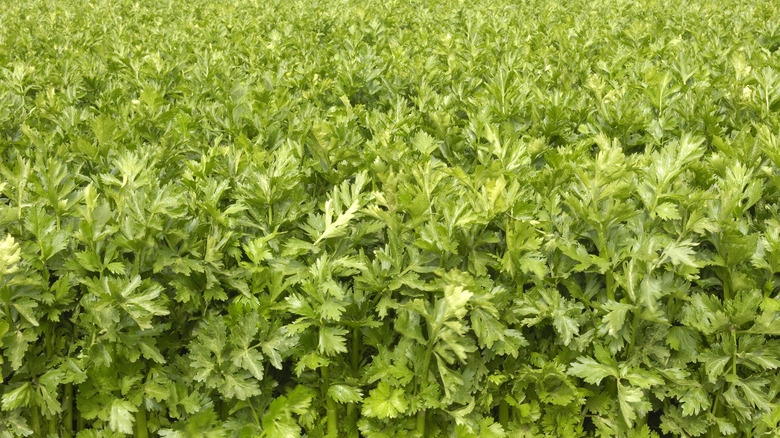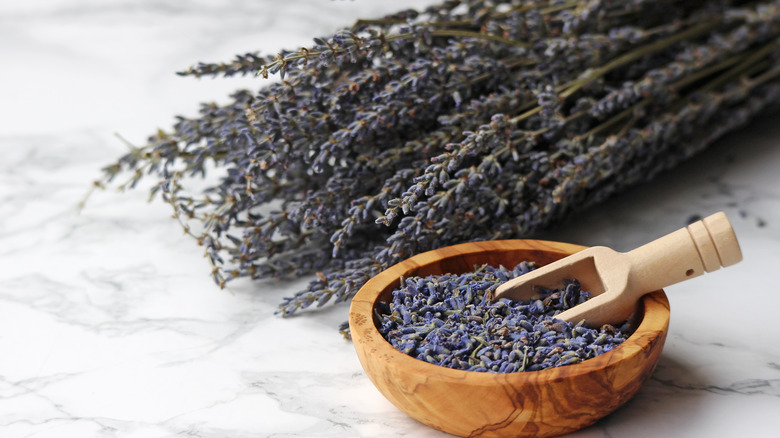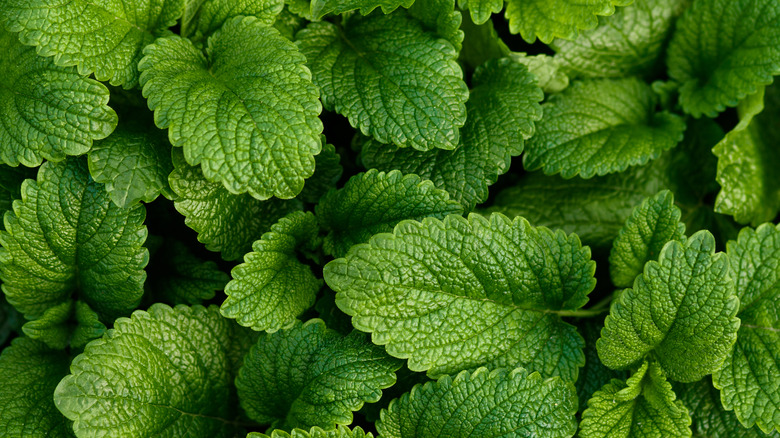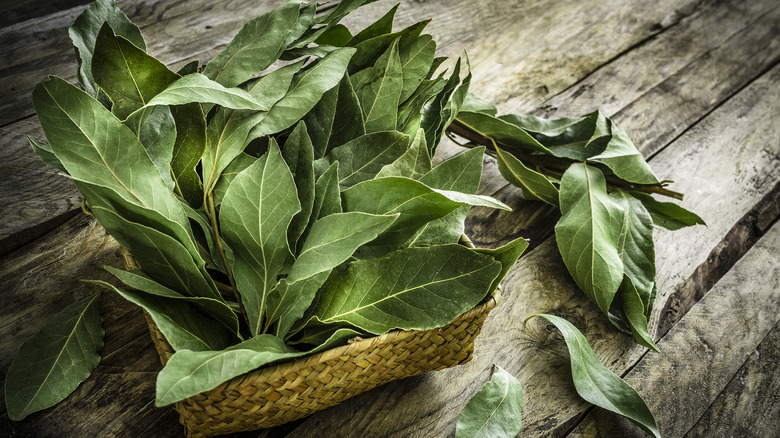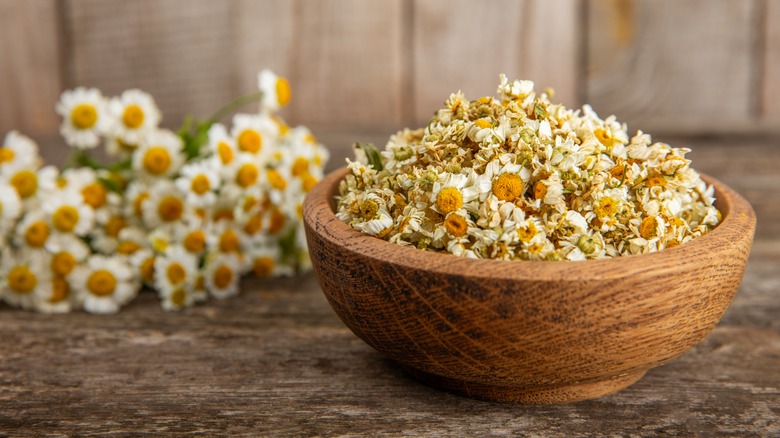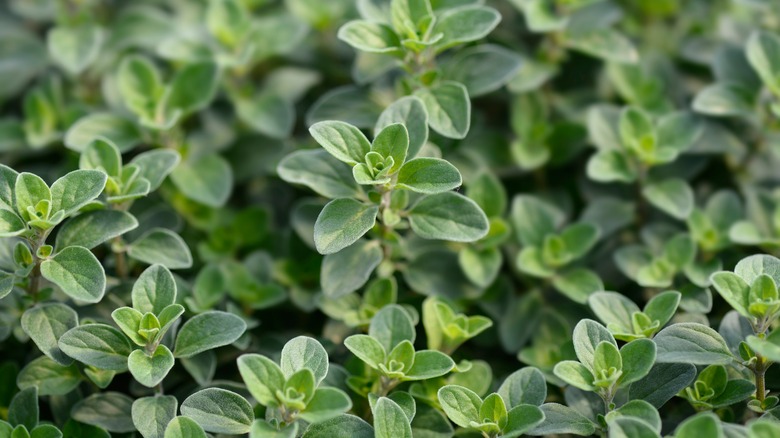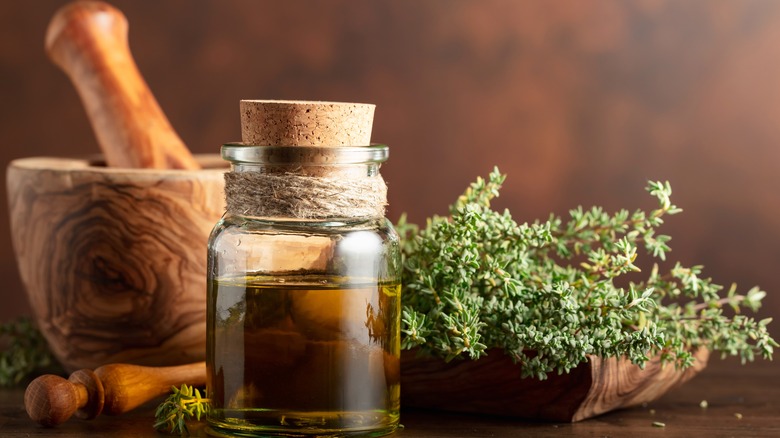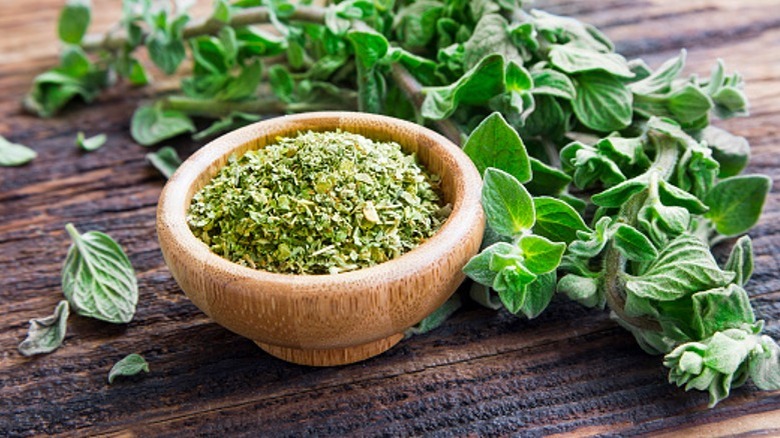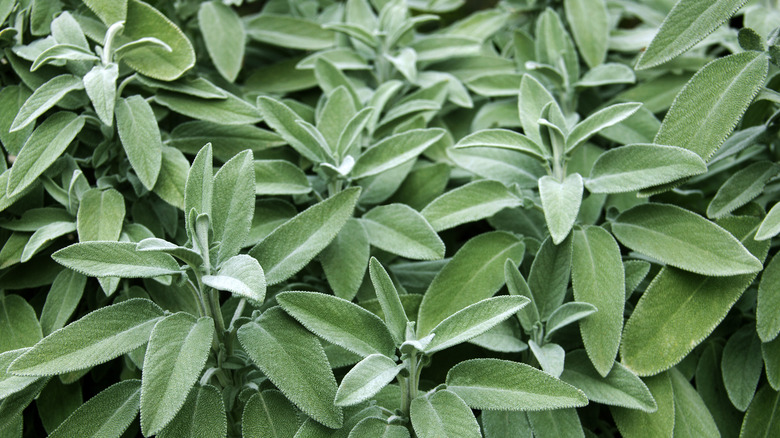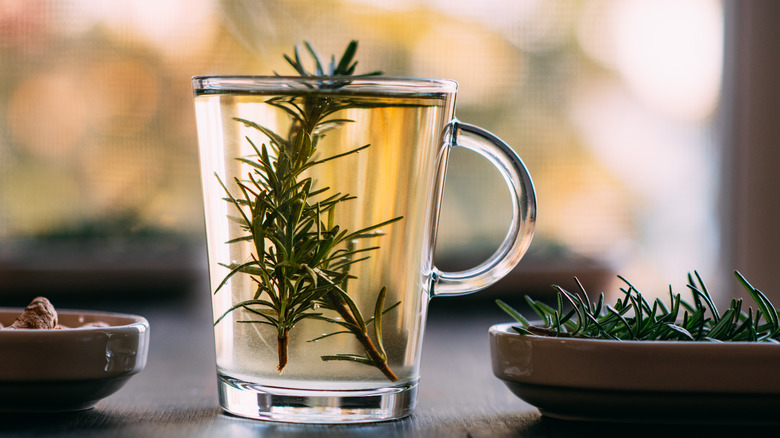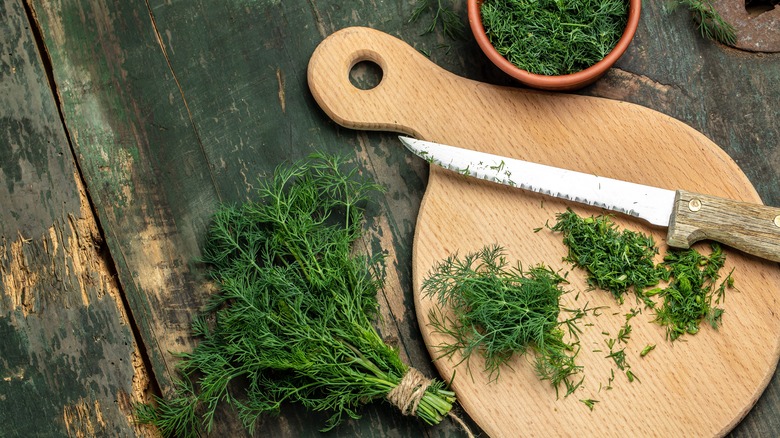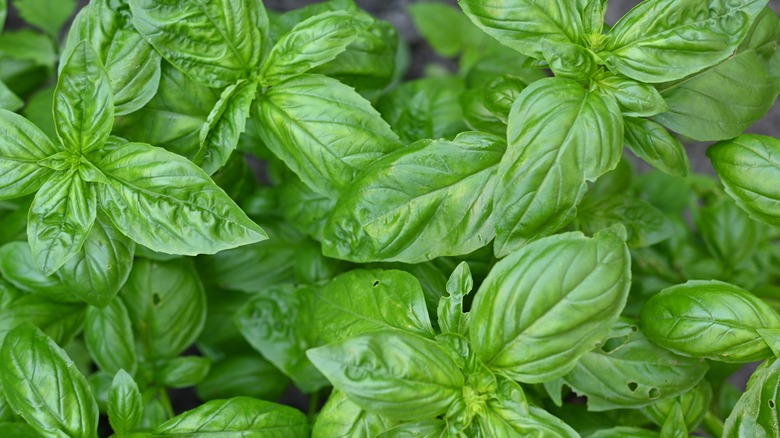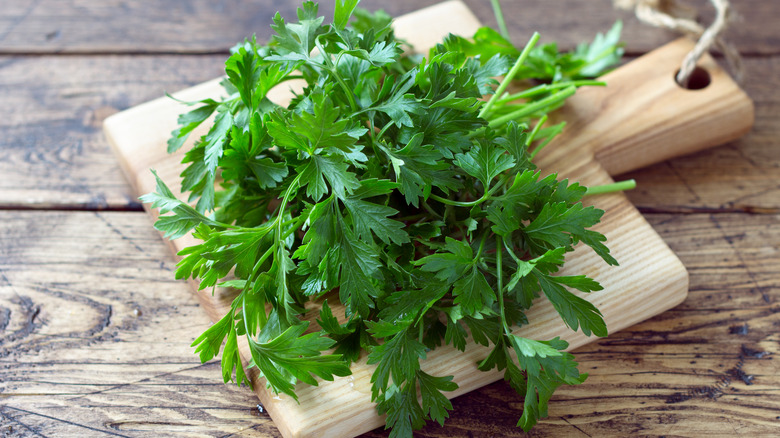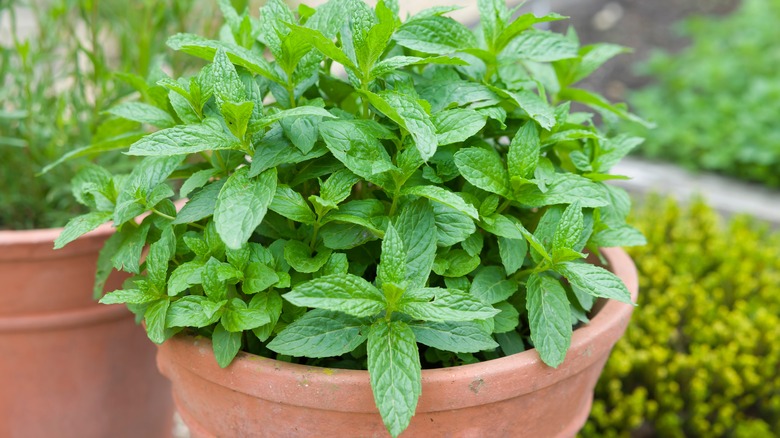The Best Herbs To Have In Your Kitchen, Ranked By Versatility
Herbs in your kitchen or garden do more than just contribute aesthetic appeal and greenery to your home. Of course, they're used for cooking — everything from sweet to savory, in both foods and drinks. And herbs have been used for medicinal and spiritual purposes throughout recorded history.
To determine the best herbs to have in your kitchen, which we ranked by versatility, we considered each herb's overall popularity, the history of the herb, its culinary taste and contributions to recipes, and any uses the herb offers beyond cooking. Though we focused on what common types of herbs can do for us, we also took into account the ease of obtaining and storing the plant's fresh or dried leaves. To be honest, we'd recommend stocking just about the whole list, and probably more. After all, there's a reason herbs have been treasured since ancient times.
15. Lemongrass
You probably should be cooking with lemongrass more often, since this aromatic herb lends a citrusy background to foods while adding a sharp, grassy undertone, similar to ginger root. It doesn't rank higher on the list because of its sharp bite, which gives it a somewhat distinct taste that not everyone likes. But that sharp bite goes well with rich, spicy flavors, and if you enjoy Asian, Vietnamese, or Thai cuisine, chances are, you like lemongrass.
This herb also lost points for our list since it requires more complex preparation when cooking with lemongrass, so it may not be the first thing you reach for. However, this bright, fragrant herb livens up both savory and sweet dishes, be they salads, soups, tea, or cocktails. It also pairs well with beef and pork. But even if you didn't want to take the time to add lemongrass to your kitchen table, it will decorate and brighten up your garden.
14. Leaf celery
Leaf celery is almost as versatile as celery itself — a vegetable that grows as a bunch of long sturdy stalks, topped with a small bunch of leaves. But of course, celery is not an herb. Neither are the edible leaves that are frequently chopped off before being sold to the public. (Those greens can add zest to salads, dressings, soups, and eggs, so you may want to stop throwing away celery leaves.) Instead, there's leaf celery, an herbal version of the vegetable. It's not quite as versatile as celery, but it's a fresher option than dried celery.
Is leaf celery the same as the leaves from the top of celery stalks? Unlike raw leaves from the top of a celery stalk, leaf celery is not eaten raw. It's typically added to slow or long-simmering dishes, where it offers a deeper, earthier flavor than the vegetable does. But leaf celery can season many of the same dishes, such as soups, stews, chowders, and sauces. Bonus: leaf celery is easier to grow than celery.
13. Lavender
Gracing your garden with a brilliant purple and intoxicating fragrance, lavender is a popular herb just based on look and scent — but lavender is much more than a pretty face or pleasant aroma. Recognized in ancient Roman times as an effective bath enhancer, lavender gives the user a wide range of options, from body care to cooking. Lavender is even documented to help repel mosquitoes.
Since lavender is versatile inside and outside the home, it's worth having in your kitchen, either fresh or dried. It's important to know how to select the best lavender for cooking, since not all lavender is treated equally. Lavender is sometimes referenced with rosemary when determining companionable food or drink. Both herbs feature a strong, earthy presence that does well with hearty ingredients, such as deep cuts of meat and rich cream-based dishes. Lavender is a great choice for infusing, too, whether it's in an oil, vinegar, tea, lemonade, or cocktail.
12. Lemon balm
Lemon balm, which belongs to the mint family, is not something you typically find in the average kitchen. This herb is a tasteful mix of light mint and lemon, with both flavor profiles matching any number of hot and cold foods and drinks, savory or sweet. Its aroma is mildly lemony but the leaves are similar to mint: decorative, fragrant, hearty, and bright green. Fresh lemon balm makes a pleasant garnish and brightens up a salad, but it also enhances potpourris, boosts body care products, and is planted as a bug repellent.
Lemon balm seems quite versatile, especially when you consider that it seasons sauces, is brewed for tea, and adds to infused oil and vinegar ... but we didn't rank it highly, simply because when adding lemon flavor, we typically reach for a lemon. But lemon balm has its place in the kitchen for those recipes that call for a different form of lemon seasoning. And, lemon balm makes a great substitute for bergamot.
11. Bay leaves
The ancient Greeks used wreaths of bay leaves as a sign of the highest honor, and it was looked upon medicinally in the Middle Ages, but that's not why we cook with bay leaves. Bay leaf is used as an herb that enhances food with its strong, powerful flavor, despite its primarily inedible nature.
Bay leaves are large, dense, and fairly tough, providing a deep, earthy undertone that adds a rich base to your dish. For that reason the whole leaves make a good accompaniment to soups, stews, and sauces that slow cook for a while. Whole, crushed, or ground, dried leaves are the preferred versions to work with. Fresh bay leaves can be considered as well, but the dish may become too pungent. The leaf itself remains fairly tough during the cooking process, and is removed before serving.
Bay leaf marries well with poultry and fish, and is a main factor in homemade versions of Old Bay seasoning. Dried bay leaves have a long shelf life, either stored in your pantry or freezer. Fresh bay leaves can be kept in the fridge or freezer for a longer storage time.
10. Chamomile
Chamomile is a well-known herb, but it's mostly popular for brewing into a soothing, calming, and refreshing tea. So sometimes, chamomile is overlooked for just about anything else. But this light, bright, flowery, slightly sweet herb complements varied dishes and drinks beyond just the nighttime cup of tea. Even though it's a relatively mild herb, chamomile highlights other light, bright foods, like fruit. In fact, if you haven't quite gotten past just the tea, try a chamomile stone fruit salad to help broaden your herby horizons.
Fragrant and decorative, chamomile can be showcased in flower or plant arrangements, as well as used in aromatics or potpourris. Chamomile makes a great companion plant — it's cherished by fruit farmers who plant chamomile near their orchards to prevent fungal growth — and is beneficial to grow alongside your basil, cucumbers, cabbage, and apple trees. Even if you don't want to eat or drink chamomile, try rinsing your hair with a cooled cup of chamomile tea, or place the cool or cold tea bags on your eyes to reduce puffiness. (We've tried both. We like both.)
9. Marjoram
Marjoram is a rather underrated herb, an afterthought to many, but it's one that deserves a place in your spice blends (and this list). If oregano was crossed with basil, you'd have something like marjoram — an herb that's mildly earthy and both peppery and sweet. Where oregano favors the pepper side and basil favors the sweet side, smack dab in the middle sits marjoram.
Can marjoram and oregano be swapped in recipes? The short answer is yes. It's not a match-for-match, but it will do in a pinch, and that's one reason why it's a solid herb to have in your kitchen. If you're preparing a recipe with both oregano and basil but want less of an herby flavor presence, replace the oregano with marjoram. On its own, marjoram highlights pork, poultry, and fish, as well as pasta or potato dishes, with or without a sauce or cream topping. Marjoram may be mild, but it can also be infused into oil, butter, or vinegar.
8. Thyme
Part of the mint family, thyme isn't enjoyed raw like parsley or basil. More than likely, though, thyme has been included in some of your favorite dishes, especially since thyme is a staple in Italian seasoning blends and shows up frequently in Thanksgiving dishes. Classed in multiple varieties — including common, French, and golden lemon types — thyme isn't as popular as parsley or mint, but it is a pleasant-looking herb that adds to your garden and enhances bouquets. Ensure you know what to look for when buying fresh thyme so that you end up with a luscious, vibrant plant.
Thyme is an earthy herb; the lemon variety features a citrusy twist. Because of its lighter woodsy undertones, thyme works well in both food and drink, sweet or savory. Lemon thyme pairs especially well with dishes, desserts, and drinks that feature citrus. Thyme can be used in place of rosemary or basil, depending on the recipe profile, and is a choice herb for infusing with oil, butter, or vinegar. Grow it alongside your other must-have herbs and store it in the fridge for use up to two weeks.
7. Oregano
Oregano could probably battle most of the herbs on this list and come out on top most of the time as a go-to herb for the culinary side of life. As a member of the mint family, oregano is a close cousin to marjoram, basil, and thyme, with similarities to rosemary and sage. Found frequently in Greek, Italian, and Mexican recipes, oregano is favored for savory dishes that feature deep, rich, earthy ingredients that go well with acidic, tangy, or peppery notes. Hello, pizza!
Oregano could have had a higher spot on this list, but as far as versatility goes, oregano is used mostly in its dried state; in its raw state, oregano can overpower other ingredients easily. However, raw oregano makes a refreshing tea and can also be an excellent option for infusing into oil or vinegar, where the flavor becomes subdued. Maximizing the flavor of dried oregano requires only the simple step of grinding it in your hands, landing oregano firmly in the top 10 best herbs for the kitchen.
6. Sage
Sage is visually warming while lending flair and flavor to create comfort foods and drinks. Sage adds depth to recipes and appeal to your garden. Though it may not suit everyone's taste buds, sage has been a culinary staple for thousands of years due to its flavor-enhancing properties, tea-brewing compatibility, and medicinal qualities.
Sage goes well in savory foods like sausages and sweeter dishes such as skillet cornbread and honey blackberry pie. Sage carries a deeper, earthier taste than many other herbs, with a flavor that borders on sweet to tangy, like citrus. The leaves are hearty and bold, with a slightly fuzzy appearance, and sage stands up well amid rich ingredients and slow-cooking sauces or soups.
As popular as sage is for food and drink, it's also used in tribal ceremonies for cleansing rituals that are believed to bring about balanced energies. Sage is also found in body care products for its medicinal qualities and earthy scent, which may also conveniently deter pests such as mosquitoes.
5. Rosemary
Rosemary could have been further up the list if it didn't come with a love-hate relationship. Whether you enjoy the smell and taste of rosemary or not, it's certainly one of the most versatile herbs to have in your kitchen. Known for its bright, citrus-meets-pine scent and taste (it even resembles pine tree needles, making it an excellent holiday-season add-in for a glass of champagne), rosemary brings a nice accent to other ingredients, though it can become overpowering, turning foods bitter as a result.
But when used correctly, rosemary provides flavor for down-to-earth, homey recipes like no-knead rosemary bread and easy homemade focaccia. Fresh rosemary livens up oil, butter, or vinegar when infused, and pairs well with acidic ingredients, such as lemon, tomato, or wine, along with tart fruits like cranberries or raspberries. Given its piney nature, rosemary complements just about all meat and fish, and can be a substitute for thyme.
Rosemary is a flowering evergreen shrub that grows nicely in the ground or in containers alongside lavender and thyme. While growing, rosemary provides scenery, a nice aroma, and pest control. It also serves well as a food preservative, and may even be considered as an analgesic agent and digestive aid.
4. Dill
Dill is an herb that resembles a bright green feather duster, but thankfully, it's not meant for dusting off your countertops. It is, however, a versatile herb that was once regarded as a symbol of good luck in ancient Rome. Also used as a breath freshener and a natural dye, dill is a delicate-looking herb that makes a good companion plant to your thyme, deterring pests while adding pleasing greenery to your garden.
Fresh, vibrant, and highly fragrant, this herb plays the starring role in classic dill pickles, but is also a welcome seasoning for pickling other foods. Completely edible, this light herb is often displayed as a garnish, but instantly jazzes up the right dish or drink with its bright, slightly tangy profile. Dill is added to all kinds of salads — from cucumber salad to egg salad to potato salad to pasta salad to chicken salad ... well, you get the idea.
Aside from flavoring pickles and salads, dill complements fish, vegetables, and meat, and can substitute for fennel. But since it is a fragile herb, dill is best for short cook times, infusing flavor, and adding finishing touches.
3. Basil
Basil is part of the mint family and a well-loved herb that's frequently grown and used in the kitchen. It's a companion plant (often with tomatoes) in your garden to help deter insects like ants and cabbage worms. With over a dozen types of basil to choose from, this herb goes well with hot and cold foods and drinks, savory or sweet, allowing you to create a menu full of basil-intense recipes.
The main star in a classic pesto, basil is also used in stir-fry dishes, various types of salads and dressings, dips, infused oils, compound butter, and sauces. It's a main ingredient in Italian seasoning, but it doesn't just complement pasta, bread, and vegetables — basil works with fruit (such as strawberries, cantaloupe, lemon, or watermelon) to create fresh, vibrant sweets such as cake, ice cream, sherbet, cocktails, and fizzy drinks.
Sweet basil is the most common variety of this herb, and the one you might have in your pantry already. But you can grow other types for additional taste sensations, like Thai basil for a licorice flavor, lemon basil with a citrus taste, and cinnamon basil for a spicy touch. Basil leaves can be frozen whole or chopped, and can also be dried; both forms provide you with a lengthy storage time.
2. Parsley
Long gone are the days when parsley was only used for garnish or cleansing the palate. This deep-green herb has a mild flavor but pairs well with a plethora of foods and drinks, and it earns a top spot for cooking versatility alone. Parsley doesn't grow as easily as other herbs, but adding it to your garden is worth what it gives back. Parsley brightens a dish, adds greenery to a bouquet, can be made into parsley wine, and makes a great companion plant to keep garden pests away. With multiple ways to keep parsley fresh, this herb can be a handy presence in the kitchen.
Coming from the same family as dill, parsley is classed into four varieties: flat-leaf, curly-leaf, parsley root, and Japanese parsley. Flat-leaf parsley, also known as Italian parsley, is the most commonly used and preferred version because of its earthy, somewhat peppery flavor. Seen in everything from tabbouleh to chimichurri to ice cream to cake — and contributing as a main herb in ranch seasoning — parsley is a must-have in the kitchen. Whether it takes on a savory role in parsley potatoes or crispy artichokes, or aids in crafting creative sweets, parsley adds something to food and drink in a subtle-but-earthy way. Not to mention its lead role in the seasoning quartet of Simon and Garfunkel's "Scarborough Fair" (along with sage, rosemary, and thyme).
1. Mint
Mint hits the top of our list as the most versatile herb to have in your kitchen because in addition to being useful for cooking, it's also good for cleaning, deodorizing, and even repelling a range of pests while attracting beneficial insects — all as it makes the treated area smell fresh and lively. Mint is often added to perfumes and body care products for its crisp, clean smell. Additionally, fresh mint is easy to raise and grows fast, inside or out, providing natural aromatherapy.
A go-to herb for a range of savory and sweet dishes, mint makes the mouth tingle, waking up all the senses; it is often considered a pick-me-up. The leaves make an eye-catching garnish, and can be the star of drinks and cocktails. Mint introduces itself with a pop of cool and mild sweetness, followed by a punchy kick, but the variety of mint used can make a big difference in a recipe.
The most familiar mints are spearmint and peppermint. Between these two popular types there is a noticeable difference in taste that could change a classic cocktail, which is why the mint you use in a mint julep actually matters. Having a few varieties of mint growing together in your garden offers you the opportunity to whip up refreshing mint recipes at a moment's notice. Keep mint fresh for months by freezing or drying it.
